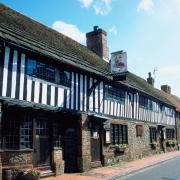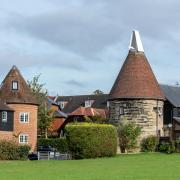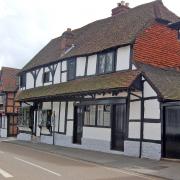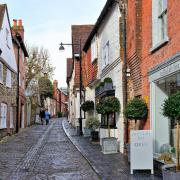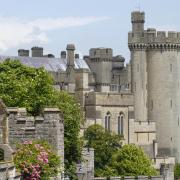The soil of Sussex conceals the stories of how our ancestors lived their lives. Metal detecting enthusiasts spend their free time searching out and unearthing these treasures, as Jo Steele discovers
UNEARTHING treasure has acquired a rather exciting image thanks to Channel Four’s Time Team and movie adventurer Indiana Jones.
However, the reality can be rather less glamorous. Come rain or shine, metal detectorists can be found across Sussex, sweeping across fields and listening attentively to the signal from their machines.
Metal detecting enthusiasts in the county have discovered tens of thousands of items since official records began.
The Government established the Portable Antiquities Scheme (PAS), an online artefact database, in 1997 to record the wealth of archaeological findings. More than 15,000 records have been made of items found in Sussex since the scheme started in the county seven years ago. Many of the records include multiple items, like ceramic sherds or flint tools. Last year alone, approximately 2,200 records were created for 2,969 objects. The majority of the discoveries are the result of the endeavours of metal detecting enthusiasts.
The county currently has nine active metal detecting clubs, some of which have more than 50 members.
“Some people might see it as a bit of an anoraky hobby, but I do it because it’s interesting to find things that belonged to people who walked where we do,” says Peter Abbott, a member of Brighton and District Metal Detector Club. “I’m not in it for the money. I like to discover the history of an object.”
Peter’s favourite find is the first Roman coin he discovered. He says: “It is amazing to think that the South Downs was a bit like a motorway for the Romans. Every 12 miles they built a fort.”
The club has been going nearly 40 years and meets every Sunday, weather permitting. Peter is proud of its charity work. Last year they raised just under �2,000 for local charities from rallies.
For Paul Robbins, chairman of Selsey Searchers, it was a hobby his father passed down to him. “I used to go metal detecting with my dad when I was a boy. In fact, I still use his spade.”
The Selsey Searchers have 52 members, of all ages. Paul says: “There is a real diversity of people who do it. I’m a building surveyor, but we also have a cameraman, an IT worker…all sorts of people.
“Metal detecting is a friendly hobby. It’s a bonus if you find something!”
The club tries to organise a search event every weekend. They start at 8.30am and go on all day. “We search every inch of an area because it can be so easy to miss something by a matter of inches. We might search a field one year and think there’s not much in it, but then when it is ploughed the following year it’s like a whole new area to search,” says Paul.
He likes metal detecting because: “You never know what you’ll find, it’s the unknown. And, then researching what you find on the internet, in books or at a museum. Finding out about the stories behind the things you find.”
Among the favourite items he’s unearthed is a Celtic silver unit, which he describes as “an unrecorded coin, one of a kind. That has since been recorded with the Celtic Coin Index which will obviously add to our understanding of the Celts that lived on the south coast”, and an 11th Century Viking stirrup mount. Club members have found coins and artefacts ranging from the Iron Age, roman and medieval eras including hammered coins from the reigns of Edward I and Elizabeth I.
Stephanie Smith, finds liaison officer for Sussex, says: “When you think about the story behind the objects, where they were found, how they were found, and what they can tell us, it can be pretty awe-inspiring.”
Stephanie’s job includes being responsible for recording all objects that are more than 300 years old brought to her as part of the PAS. She is also responsible for taking care of treasure cases and building relationships between finders, land owners, museums, and local coroners as part of the Treasure Act.
Stephanie, who is based in Lewes, says: “Every day in my job is different and exciting.
“On a weekly basis I see all sorts of interesting artefacts, from prehistoric flint tools to Bronze Age axes to Iron Age and Roman coins and brooches to medieval dress accessories – the list goes on and on!”
She says one of the most important things about the artefacts database is that they record each object’s ‘findspot’, or grid reference. “This is so that people researching various object types and periods of activity can draw conclusions on how our landscape was used by people over time.
“With this information in hand, we can compare the information available from other types of records, like the Historic Environment Record and list of Scheduled Monuments, to create a more in-depth picture of our past.”
Rob Clements, a cleaner from Brighton, hit the headlines last year when he struck lucky just months after buying his first metal detector.
He found a unique Roman coin made by an ancient ‘Del Boy’ forger who could not spell and did not know his emperors.
The silver denarius, an average day’s pay for a Roman worker, is based on coins struck to commemorate the Battle of Actium between Octavian and the combined forces of Mark Antony and Cleopatra in 31 BC.
But the forger got most of his inscriptions wrong. He crafted his coin some years after the battle but had a poor memory of what the real one looked like. On one side is a crocodile but it is facing the wrong way. On the other side is the head of Emperor Caesar when it should have been Augustus.
And he misspelled Egypt – he had Aegipto instead of the common spelling of the time, Aegypto or Aegvpto.
Experts at the British Museum have said the coin is a mystery because it is made from solid silver and probably cost the forger as much to make as he received in profit. Its rarity has pushed up its value from �100 for a genuine coin to at least �3,000.
Rob now intends using his earnings to finance his plans to study the Romans at the University of Brighton where he works.
Rob discovered the coin lying two inches beneath the surface on a grass path in open ground on the outskirts of Brighton.
He said: “Since finding it, it’s all been a bit surreal with requests for newspaper and other interviews.”
He said he never thought he’d find anything so interesting and valuable – and so soon after getting a detector.
“It’s fascinating that there were forgers at the time, some, it seems who were not very bright. I’ve always been a fan of Only Fools and Horses and it’s amazing that I’ve connected with a Del Boy who lived 2,000 years ago,” he says.
Over recent years, heritage bosses have expressed fears that parts of Britain’s history are being lost as illegal treasure hunters – or ‘nighthawkers’ – dig up artefacts to sell on.
A UK-wide study found the threat to archaeological items was high, but prosecutions were at an all-time low and penalties “woefully insufficient”. The English Heritage-commissioned report said criminals were using auction websites to sell antiquities. Many items are said to be worth little financially but of historical value.
In February, the Alliance to Reduce Crime against Heritage was launched to investigate the growing number of heritage crimes. The team, which includes English Heritage, the National Trust, the Woodland Trust and the Historic Houses Association, will assist Sussex Police in investigating vandalism and criminal damage to historic monuments. The idea is that councils across Sussex will join forces with the police, local history societies and the wider public to provide a network of intelligence.
Illegal metal detecting is defined as “the search and removal of antiquities from the ground using metal detectors without the permission of the landowners or on prohibited land such as scheduled monuments”. It is a form of theft and can be prosecuted under the Theft Act.
Stephanie says of nighthawking: “As far as illicit metal detecting, I think that one of the most frustrating aspects for those ethically detecting is dealing with the negative perception some have of metal detecting because of those that are breaking the law.
“As a region that is incredibly rich in archeological sites there is significant temptation and we do have to take the issue of nighthawking very seriously as a threat to our national heritage.
“The clearest statement I can make is that individuals participating in this type of behaviour are not only breaking the law, but are endangering our ability to preserve our past for ourselves and future generations. Luckily, the positive and ethical detecting practiced by many detectorists and result of their work with the PAS are helping to change this perception.”
Some significant – and unusual – Sussex finds include:
Patching Hoard
The Patching Hoard was 22 Roman gold coins, 25 Roman silver coins, two gold rings and scrap silver. Discovered in April 1997, and excavated in April and May of the same year, the hoard was discovered by two local men who were searching the field using their metal detectors. A Treasure Trove Inquest was told the hoard must have represented a very large sum of money in the fifth century.
Prosthetic nose
According to Stephanie Smith, finds liaison officer for Sussex, one of the most unusual finds was a copper alloy prosthetic nose. It is thought to date from medieval times. It was discovered in East Sussex last year. Stephanie says: “These false noses were worn by individuals who had lost their own either to accident or disease, particularly victims of syphilis. These noses were also produced in silver – perhaps like changing one’s shoes for a special occasion!” The 4.5cm-long item has two nostril slits at the base and a flattened rim around the top and sides.
High Weald Hoard
The High Weald Hoard of 1,900 roman coins lay undiscovered for at least 1,800 years before it was found in 2005. One of the coins in the hoard, commemorating the Empress Cornelia, was valued at more than �4,000. Another, dating from the period of Empress Tranquillina, was dated to the third century AD, a troubled period in the Roman Empire.
Petworth Hoard
A hoard of treasure, which included two unique, previously unrecorded, types of coin. The 103 coins found covered a date range from the late 3rd century BC to AD134. The earliest date is significantly earlier than the Roman invasion, which occurred in AD43. The 103 coins found equated to a third of a year’s wages for a Roman soldier, and could indicate that wealthy people were living in the Petworth area in Roman times. The hoard was discovered in 2006 on a Petworth farm.







